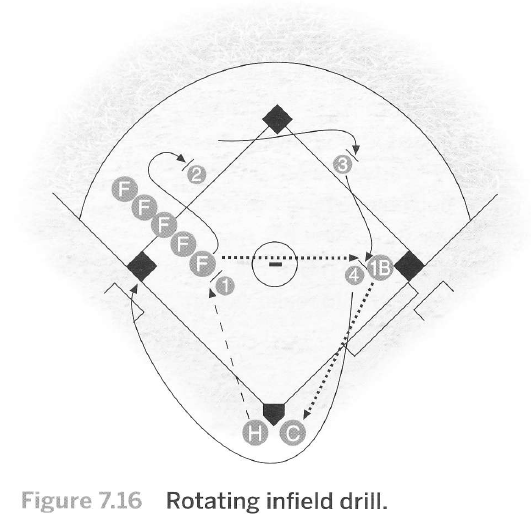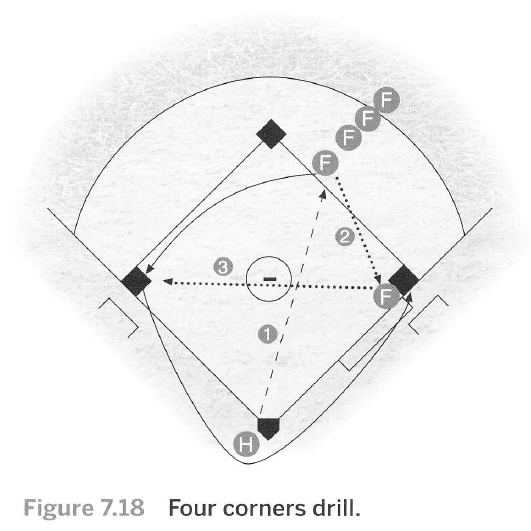| Infield Practice Drills
When a coach or player is hitting to the infield, the catcher should place the next ball in the hitter's extended hand. This allows the coach or hitter to keep her eyes on the infield play, and it replaces the toss that too often ends up in the hitter's face. Competition makes the drills more gamelike, and using runners allows the defense to develop timing and game speed. A variety of ground-ball drills and specific game situations should be used to make sure all techniques are covered. Drills that improve conditioning should also be included. The following combination drills add variety to infield practice while accomplishing several goals. Rotating Infield Safety Reminders - Infielders must make sure that the first-base player is ready to receive the ball. This is good practice in looking to see the target before throwing, a routine that infielders should always follow in a game. - Infielders must run to the next line so that they are not in the way of the hit or throw. From first base, they run behind the hitter.
Procedure: Players form two fielding lines at opposite corners of the infield—one to the left of second base and one at home (see figure 7.17). Players in line at second must be careful not to trip over the base. Two hitters hit or throw from the area of the pitching circle, one to each line. Players field and then run to the end of the opposite line. Hitters hit ground balls, fly balls, range balls, line drives, and scoops. Players return the ball to their hitter or place it in a bucket at the line they are running to. Hitters should have a bucket of extra balls to replace balls that fielders miss so that the drill can be done at a steady pace. 4 x 4 Gut Procedure: Infielders take normal defensive positions with a hitter and catcher at home. The hitter hits four times to one player, who fields the balls and throws in order to home, first, second, and third. If an error occurs, she must start over. The cycle is repeated three more times. Four Corners Procedure: Infielders form a line at the second-base position. One fielder is at first base. A hitter hits to the first infielder in line. The fielder at second base fields the ball, throws to first, and sprints to third base to receive a return throw from the player at first (see figure 7.18). The fielder must be at third in proper receiving position (left foot against the home plate side of third), where she catches the ball and applies a tag. The fielder then sprints home to give the ball to the hitter and runs behind the hitter on the way to first; she must get to first base in time to catch the throw to first on the next hit ball. The fielder catches the ball at first base, throws back to the next fielder at third base, and goes to the end of the line at second base to wait for her next turn. Use no more than five players so that there is not a lot of standing around. Have an extra bucket of balls at home and first in case of errant throws.
Procedure: Three fielders form a line at third, and a first-base player and catcher take their normal positions (see figure 7.19). A softball is placed on the mound. A hitter at home hits to the first fielder at the third-base defensive position (1). The player fields the ball and throws to first. (Balls thrown to first are thrown immediately by the first-base player to the catcher at home.) She then runs to the ball on the mound and throws to first (2). The fielder runs around behind second base, fields another ball hit to the shortstop position (3), and throws that ball home. The hitter rolls a ball out to the same fielder, who is charging home (4). The fielder fields that ball and places it on the mound. The drill continues with the next fielder. The catcher and first-base player should take a turn fielding the ball.
|
|
|






 Infield Loop
Infield Loop


